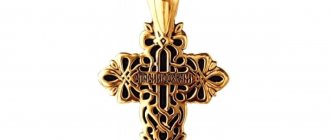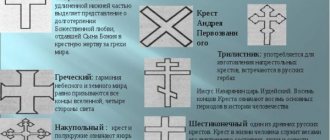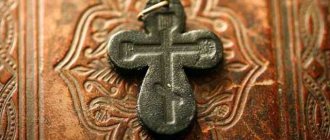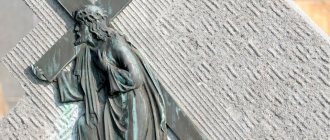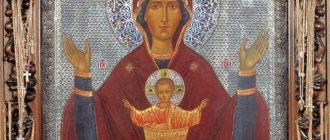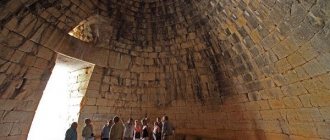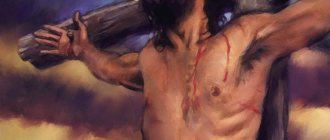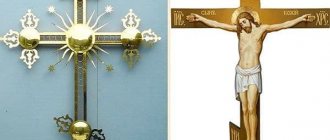“But even at the hour of death I will not become different, and no one will give me a cross,” promises a militant atheist character in one song. This is a vivid example of the fact that the grave cross is a symbol of human beliefs, his devotion to faith and hopes for eternal salvation.
We either accept them or reject them. But for many, a cross in a cemetery is just a formality, which, if you think about it, even a Christian can do without.
“Well, the cross doesn’t fit into the funeral composition, it doesn’t go with the tombstone, we’ll do without it.” And really, is it really necessary, since the person has already died?
The cross became a symbol of eternal life long before Christianity
In general, crosses as a religious symbol are not an invention of Christianity. This is one of the simplest images that could ever come to a person's mind.
It is not surprising that cruciform images have been found on almost all continents since the ancient times of the Neolithic and Paleolithic.
The meaning of these images is clearly religious, for many of them were made in difficult-to-reach cave spaces and at high altitudes. Obviously, people painted such images not for entertainment, but with a sacred meaning.
People have depicted crosses since ancient times and invested them with sacred meaning.
There is no consensus among religious scholars and historians about what the cross meant for our distant ancestors. There is, for example, an opinion that an x-shaped cross is the simplest image of a person.
But in observable history, the cross is already astrological, mystical and religious symbol. Let's talk about this further.
Four-pointed Catholic shape
The burials of Catholics are traditionally overshadowed by a laconic four-pointed cross with an elongated vertical axis. Historically, this form dates back to the times of the first Christians, who drew similar images on the walls of the Roman catacombs. For all who believed, the instrument of shameful execution became a symbol of salvation and a promise of new life, and persecuted Christianity turned into a world religion, one of the influential centers of which continues to be the once pagan Rome.
The cross at Catholic burials previously had only one location option - like a banner, at the head of the burial. Nowadays it is also placed in the legs.
For ancient people, the cross is a symbol of the sun and God
The cross became established in astrology during the Neolithic era. He was depicted in the center of a circle, which served to symbolize the sun.
We don't need to be afraid of astrology. Orthodoxy actively criticizes various newspaper fortune tellers and charlatans who publish “star forecasts for the coming week.” But ancient astrology and astronomy are a completely different science.
Then there was no gap between religion and the study of the sky, everything was connected, and every person understood that the stars are a projection of divine energy into our world.
The solar cross - since ancient times, this symbol has been revered by people in different variations. It lies at the heart of the Christian cross. Photo: upload.wikimedia.org
Accordingly, they monitored the sky, made forecasts based on observations, calculated calendars, set dates for holidays, and oriented crops based on the celestial bodies. And the survival of a person who began to master agriculture depended on this.
The sun is a giver of warmth and light and an expression of God’s care, which means that through it you can direct your gratitude to the Almighty. So it makes sense to talk not about the cult of the sun, but the sun as a connecting element of the earthly and divine. The cross is a symbol, a place of fusion of matter and spirit, a door to the other world.
Today's astronomers have established this symbol for the earth, but we know that initially everything was not so.
The Christian cross was preceded by the Egyptian ankh - a symbol of eternal life
The cross-sun passed into different religious traditions. After all, the experience of our ancestors has not disappeared. Ancient Egypt has preserved for us a more transcendental view of the cross than was probably originally attributed to it.
The gothic subculture widely disseminated the "ankh" symbol. Perhaps everyone saw him today. But we are interested in what the ancient Egyptians saw in the ankh - a symbol of eternal life, a promise that the soul does not disappear after death, but passes into a different state in the afterlife.
The Ankh is a symbol of eternal life even before the Christian cross. Photo: salik.biz
We will not dwell in detail on Egyptian beliefs. Let’s just say that the ankh looks even more like the figure of a man with outstretched arms - due to the loop at the top of the symbol.
It is the connection of the cross with afterlife symbolism that is the thread that closely connects the most ancient beliefs with modern Christianity.
There is no need to be afraid of this. This does not mean at all that Christianity is some kind of secondary religion.
We just have to understand that nothing comes out of nowhere.
Theological thoughts, images, spiritual experience - all this is rethought and supplemented by new traditions, but internal knowledge of the divine has always accompanied humanity, including in pre-Christian eras.
After all, was Noah a Christian? Of course not. But this did not stop him from being a pious and believing person.
Where to put the cross from the grave after installing the monument?
After installing a permanent monument or cross, a temporary wooden crucifix can be buried next to the grave
, if space allows.
If the first cross was well processed and has not lost its qualities, it can be placed behind the monument
, or
given to poor families
for re-installation.
Where to put the old cross from the cemetery if it is impossible to store it? It is burned, and the ashes are scattered over the grave, either sawn into elements or given to the cemetery administration
.
The cross became a symbol of Christianity back in the 1st century
And now we come to the Christian era. At the beginning of our era, the Roman Empire firmly held influence over all of Europe, part of Asia and Africa. The orders of the ancient world spread to other states.
Methods of execution were no exception. One of them is the crucifixion. But one should not think that the Romans deliberately took a religious symbol and decided to desecrate it by killing criminals.
They simply selected the simplest and most effective designs for execution. Known are x-shaped crosses, tools in the shape of the letter “T”, pillars and the cross that would later become a symbol of Christianity.
Although the cross was a religious symbol for many peoples, a number of ancient states used it as an instrument of execution. Christ was executed according to ancient rules - just like the two criminals on each side of Him (Andrea del Castagno, “The Crucifixion”). Photo: artchive.ru
It fell to Jesus Christ to die on the cross, and here one can discern direct divine providence and symbolism. It is no coincidence that the Son of God dies on the most ancient symbol, as if announcing to all people that they are blind and do not see the obvious - the coming of the Messiah.
But already on the third day the Savior was resurrected, so His disciples clearly could no longer perceive the cross as something destructive.
But there is an alternative version, according to which the first Christians used fish and other symbols as their symbol, but already in Pompeii an image of a cross was found (Herculaneum Altar), possibly bearing a religious meaning.
For us, this may mean that already in 79 Christians revered the cross. However, this is a rather controversial statement, which has nothing to counter with captious criticism.
The Herculaneum altar in Pompeii in various stages of destruction. At the top you can see something similar to a cross. This could be evidence of the veneration of the cross by Christians in the 1st century, but most likely it was some kind of fastener, which skeptics insist on. Photo: 3.bp.blogspot.com
Dimensions and proportions
The dimensions of the funeral cross may vary. The main thing is that they correspond to the golden ratio. Standard dimensions of an Orthodox tombstone:
- — The length of the long horizontal bar is 1.6 m;
- — The length of the top crossbar is 0.4 m;
- — The interval between the transverse strips is 0.3 m;
- — The distance from the bottom bar to the ground is more than 0.5 m.
The height and width of the structure can be any. It is allowed to install even a small crucifix, but it must be proportional to other elements on the burial mound.
The dimensions and weight of the monument determine the installation method. Heavy and tall structures require additional soil strengthening.
The grave cross in the cemetery symbolizes the salvation of the deceased through the sacrifice of Christ
To understand why crosses are placed on graves, we must remember the Orthodox point of view on why Christ went to execution. He died to atone for the sins of mankind. Otherwise, all people would be doomed to go to hell, and no one would enter heaven.
But the Savior decided to suffer for those who would eventually turn to Him and repent of their sins. Therefore, the Christian cross is a symbol of the liberation of believers from the burdens of sin and their entry into eternal life.
Why are they buried 3 days after death?
But crosses in a cemetery are not tickets to heaven. They are needed to indicate that the person was striving to live in harmony with Christ.
An Orthodox cross on a grave is a tribute to tradition, but it is not required
An Orthodox cross on a grave is a formality. Anyone who says otherwise is sadly mistaken. Nowhere in the Holy Scriptures does it say that a person must be buried with a cross.
It’s just that such a tradition has formed in Orthodox society: to perform the funeral service this way, take it to the cemetery this way, and bury it with such actions. But all this is needed not so much for the deceased as for the relatives of the deceased.
The cross does not affect the posthumous fate of the soul; it is placed to make the living think.
In this way, they themselves can be reminded of the spiritual path, that life is not eternal, that it is worth spending it only on useful activities.
If you don't put a cross on the grave, nothing bad will happen.
Orthodoxy teaches that the life of a believer depends on his actions, on repentance and striving for Christ. The circumstances of death and burial do not affect the fate of the deceased either positively or negatively. This must be firmly remembered.
Armenian flourishing crosses - khachkars in Belarus
In our three cities, Minsk, Brest and Mogilev, special memorial signs made by Armenian craftsmen have been installed. Stone cross-khachkars with rich foliage decoration and carved vines symbolize eternal life. Since ancient times, they have marked the places of Armenian burials and battles in which Armenians participated. In addition, the national diaspora coordinates and ensures the installation and consecration of khachkars in memory of the people’s sacrifices. Thus, the khachkar at the Military Cemetery in Minsk is located next to the Alexander Nevsky Church, erected in honor of the soldiers who died in the Russian-Turkish war. This flourishing cross is dedicated to the memory of the victims of the Armenian genocide in the Ottoman Empire and those killed in the Spitak earthquake.
The khachkar, erected in 2014 in Mogilev, serves as a memorial sign in honor of the Armenians who fought for the liberation of the Mogilev region. A carved stone cross, erected in Brest in 2015, recalls the 200 Armenians who defended the citadel over the Bug.
City Ritual Service LLC offers to purchase and install a temporary or permanent grave cross for Christian burials. We also accept orders for the production of monuments with Orthodox and Catholic symbols. Phone +375 (44) 782 97 76 works around the clock
A cross is placed at the feet to emphasize that the deceased relied on faith
Is the cross placed at the feet or at the head? To be honest, at least from the side. This will also not affect the fate of the deceased in any way. But according to tradition, a cross is placed at the feet, and the deceased is placed with his head to the west, because the rays of the rising sun should symbolically see his face facing the east.
Sunrise is resurrection, and this position of the dead has been common since very ancient times throughout the globe.
Perhaps the cross at the feet echoes the image of the sun. But all these are indirect things that are far from Christian teaching.
This photo of the grave cross shows that the master put a lot of effort into the decorations: the “roof” is a cabbage roll, as they did before, the grape ornament is a Christian symbol. But with all this, the creator of the product made a big mistake - he positioned the bottom crossbar in a mirror manner. Photo: cs5.livemaster.ru
Superstitious priests and other representatives of “folk” religion (i.e., superstitions) say that it will be convenient for the deceased to lean on the cross when he crawls out of the grave at the Second Coming of Christ.
This is complete nonsense, which is alien to real Orthodoxy.
The most popular explanation for the position of the cross is symbolism. The deceased seems to be standing on the cross, that is, faith is the foundation of his eternal life, the person relies on it.
You can use any material for the cross, it doesn’t have to be wood.
As for the material, it is often recommended to use only a wooden cross. There is no such rule either. The Church does not prohibit any material, be it concrete or iron. There are no rules. Here is how Hieromonk Victorin (Aseev) speaks about it:
“Every Orthodox Christian must have a cross on his grave. You can put up any cross, wooden, iron, or stone. We wear crosses on our bodies made of different materials: gold, silver, and plastic.
This does not diminish the power of the cross. The devil is afraid of the image of the cross, and not the material from which it is made. The cross is a symbol of victory over death. The main thing is not the material from which the cross is made, but the cross itself.
So a cross on a grave can be made of wood, iron, or marble—any kind.”
Victorin (Avseev)
hieromonk
In general, we need to associate fewer superstitions with Orthodoxy. Whether the cross fell, whether it was stolen, dropped - all these are everyday things. There is no need to mix religion with signs or bring it to ritual formalism. Christianity appeals to our soul.
By leaving a comment, you accept the user agreement
Materials for production
Crosses are made of wood, metal, granite, marble and natural stone. When choosing a material, its durability and wear resistance are taken into account.
A wooden tombstone is installed immediately after the funeral and is a temporary structure. For such graveyards, coniferous trees are usually used. To increase the service life of a wooden monument, hardwood is used, which is additionally treated with varnishes and antiseptics.
Metal crosses are made by figured forging or using a welding machine. The material is treated with anti-corrosion impregnations, but the welding areas still remain susceptible to corrosion.
Granite or marble memorials are considered the most durable, but they are very expensive. Now budget options are made from a synthetic substitute - polymer granite.
